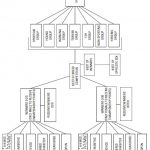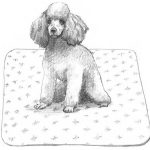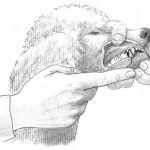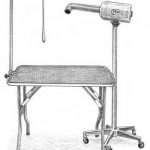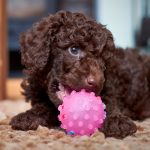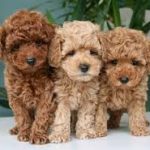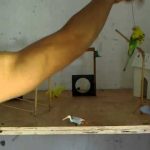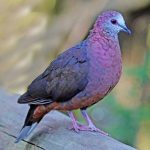Unwrapping the Whole Poodle Package
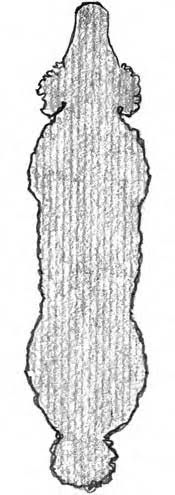
In This Chapter
- Taking a tour of the Poodle’s history
- Looking at the Poodle’s build and temperament
- Examining the requirements of different breed standards
You can just own a Poodle, period, or you can add to your enjoyment by understanding where Poodles came from, what makes a good Poodle, and maybe a little bit about why Poodles act the way they do. In this chapter, you find a bit of general canine history, discover the different sizes of Poodles, examine the anatomy of a Poodle, and get the standard: what makes a Poodle a Poodle. I also give you the scoop on a Poodle’s temperament and personality.
Walking through the History of the Breed
In the beginning, there was dog . . .
Technical Stuff
All dogs are descended from the wolf, which may explain why they howl at sirens and the like. The original dog was domesticated between 13,000 and 17,000 years ago. From those early beginnings, man has created over 300 breeds, from tiny Chihuahuas and Yorkshire Terriers to giant Great Danes, Irish Wolfhounds, and shaggy Newfoundlands. Each breed was developed with a specific purpose in mind, from sitting in a person’s lap and being a companion, to guarding livestock and property, to retrieving fallen game.
Technical Stuff
The FCI, the European organization that sponsors pan-European dog shows, regards France as the official “country of origin” of the Poodle and uses the French breed standard as the standard of judging in FCI shows. The ancestors of poodles actually originated in a number of places in Europe.
– Fifteenth-century writings and art from France, Holland, and Italy refer to Poodles. Many paintings show the Poodle in trims similar to today’s show trims (Chapter Providing Your Poodle with a Nutritious Diet has more about trims).
– German writings from the 1500s describe the “Pudel” as a large, black water retriever. Pudel or pudelin means to splash in the water. In Belgium and France, the dog was called the “Poedel.” The English name, Poodle, came from these original titles.
– In France, where the dog was popular, people also called the Poedel the Caniche, meaning duck dog. Early writings described the dog as intelligent and sturdy, with curly hair.
– The German Poodle, or Pudel, was thickset and had a wooly coat texture. Early German artwork shows the dog with both a curly and a corded coat.
The appearance of Poodle varieties
The Poodle’s modern rise in popularity
– The Standard Poodle, in the gun dog group
– The Poodle, with Miniature and Toy varieties, in the companion dog group
Look both ways when Poodle crossingPoodle crosses, such as Labradoodles and Cockapoos, are becoming very popular because it has become trendy to own a “designer breed.” People also believe that these mixed breeds will have the advantage of non-shedding, hypoallergenic coats, and that they may be easy to train because of the intelligence of the Poodle half of the mix. There’s no guarantee of any of this, though. The only sure thing is that these dogs aren’t purebreds (that is, they don’t “breed true”). Breed a Poodle with another Poodle and all the puppies will be Poodles, with Poodle coats and Poodle temperaments, instincts, and size. With a purebred, you know what you’re getting. If you breed a Poodle-Labrador cross with another Poodle-Labrador cross, some of the puppies may look more like Poodles and some may look more like Labradors. You have no way of knowing how many puppies will have the coat of a Poodle and how many will sport the coat of a Labrador. You won’t know what size the puppies will grow to as adults, nor what health issues they may face. And don’t kid yourself: You will have to deal with health issues. Mixed breeds aren’t necessarily healthier than purebreds. In spite of claims to the contrary, crossbred dogs don’t inherit the “best of both breeds.” In fact, they often have the least desirable traits of their two parents’ breeds. “Designer dogs” sell for just as much, if not more than, purebred puppies. If you want a mixed breed, check out your local shelter; chances are, you’ll find just what you’re looking for and spend a lot less money. If you want all the positive aspects of a Poodle, get a Poodle. |
Technical Stuff
Because the AKC considers all three sizes of Poodle as varieties of one breed, it publishes no separate registration figures.
Remember
Today’s Poodle is as versatile as the first Pudel that roamed a German farm, which may explain its great popularity. All three sizes make wonderful pets, and the Poodle can still herd, retrieve game, and protect. In competitive events, you’d be hard pressed to find a contest the Poodle can’t conquer, from the glamour of conformation showing to the fast-paced agility ring, to a pond of cold water in a hunt test (see Chapter Showing Off and Enjoying Your Poodle’s Talents for more about these types of events).
Picturing a Poodle’s Physical Traits and Personality
Measuring up sizes
– Standard
– Miniature
– Toy
Scoping out a Poodle’s anatomy
Taking a look at temperament
– A Standard tends to be more aloof and self-contained.
– A Miniature picks her person and wants to always be with that person. A Mini never lets up; she always wants to do something — anything — with her person.
– A Toy is happy to curl up on your lap and cuddle.
Surveying Breed Standards
The American Kennel Club
Remember
Throughout the standard, some aspects of temperament or structure are major faults. If you’re showing your Poodle, a major fault will likely get you eliminated. If your Poodle is a pet and won’t be shown, some major faults aren’t that major. For instance, a nose that is part black and part pink is a major fault in conformation, but it won’t affect your pet’s ability to be a loving companion.
General appearance and size
– General appearance: A Poodle is active, smart, dignified, and elegant. It should be squarely built and well proportioned, and should move soundly and carry itself proudly.
– Size: Size separates the three Poodle varieties in the AKC. Otherwise, the standard for each variety is identical:
- A Standard Poodle is over 15 inches at the shoulders’ highest point.
- A Miniature Poodle is 15 inches or less at the shoulders’ highest point but measures at least 10 inches.
- A Toy Poodle stands 10 inches or less at the shoulders’ highest point.
– Proportion: Poodles are a square breed. The length of a Poodle’s body from the breastbone to the point of the rump should about equal the height from the highest point of the shoulders to the ground.
– Substance: The Poodle is no lightweight. The forelegs’ and hind legs’ bone and muscle should be in proportion to the Poodle’s size. A Poodle doesn’t have thin, spindly legs and weak feet. These dogs were developed to work.
The head and neck
– Eyes: Your Poodle’s eyes should be very dark, oval, and set far enough apart so that your Poodle has an alert, intelligent expression. Round, protruding, large, or very light eyes are considered a major fault.
– Ears: A Poodle’s ears should hang close to the head and be set at or slightly below eye level. The flap should be long, wide, and thickly feathered, but the fringe shouldn’t be too long.
– Skull: A Poodle’s skull should be moderately rounded and have a slight but definite stop (the area between the muzzle and the head). The length between the occiput and the stop should be about the same as the length of the muzzle.
– Muzzle: Look for a long, straight muzzle with a little chiseling under the eyes. A major fault here is a lack of chin.
– Teeth: A Poodle’s teeth should be white and strong, and they have a scissors bite. Major faults include having an undershot, overshot, or wry mouth.
– Neck: A Poodle’s neck should be well proportioned, strong, and long. The skin at the throat should be snug, and the neck should rise from strong, smoothly muscled shoulders. The major fault here is ewe neck, which means that the top of the neck is concave rather than convex.
– Topline: The topline, or back, should be level, and it shouldn’t slope or be convex from the shoulder blade’s highest point to the tail’s base. However, there should be a slight hollow just behind the shoulder.
The body
– Body: A Poodle’s chest should be deep and moderately wide. The loin should be short, broad, and muscular, and the tail should be straight, set on high, carried up, and cut to a proper length so that the Poodle’s outline is balanced. A tail set low, curled, or carried over the back is considered a major fault.
– Forequarters: A Poodle needs strong, smoothly muscled shoulders. A steep shoulder, which shortens a dog’s gait and makes the way it moves less efficient, is a major fault.
– Forelegs: A Poodle’s forelegs are straight and parallel from the front. From the side, the elbows should be directly below the shoulders’ highest points.
– Feet: The feet should be small and oval, have well-arched toes, and be cushioned on thick, firm pads. The nails should be short but not too short, and the feet are turned neither in nor out. A major fault here is a paper or splay foot. A paper foot is a very thin, flat foot. A dog with a thin, flat foot or splayed toes will tire easily, and she may even injure herself because the foot isn’t providing the proper support.
– Hindquarters: A Poodle’s hind legs should be muscular, straight, and parallel from the rear. When the Poodle stands, the rear toes should be only slightly behind the point of the rump. Cow-hocks are a major fault. Cow-hocks are when the hock joints turn in and the feet point out. The hock joint corresponds to the heel of a person, although in a dog, it doesn’t touch the ground as a human heel does.
The coat, clips, and color
– Coat: A Poodle’s coat is curly; it has a naturally harsh, dense texture. Corded hair should hang in tight, even cords of varying length. It should be longer on the mane or body coat, head, and ears and shorter on puffs, bracelets, and pompons.
– Clip: A Poodle under 12 months may be shown in the puppy clip. In all regular classes, Poodles 12 months and over must be shown in the English saddle or continental clip. In the Stud Dog and Brood Bitch classes and in a non-competitive Parade of Champions (see Chapter Showing Off and Enjoying Your Poodle’s Talents for details), Poodles may be shown in the sporting clip. A Poodle shown in any other type of clip doesn’t meet AKC standards. Chapter Providing Your Poodle with a Nutritious Diet has full descriptions of these clips.
Tip
In all types of clips, you can leave the hair of the topknot (on the skull, from the stop to the occiput) free or hold it in place with elastic bands. The topknot is the only area where you may use elastic bands.
– Color: The coat’s color should be even and solid at the skin. In blues, grays, silvers, browns, cafe-au-laits, apricots, and creams (see Chapter Deciding Whether a Poodle Is Right for You for more about colors), the coat may show varying shades of the same color. Natural color variation isn’t considered a fault.
Brown and cafe-au-lait Poodles have liver-colored noses, eye rims, and lips; dark toenails; and dark amber eyes. Black, blue, gray, silver, cream, and white Poodles have black noses, eye rims, and lips; black or self-colored toenails; and very dark eyes. The AKC prefers the foregoing coloring in apricots, but livercolored noses, eye rims, and lips and amber eyes are allowed.
A major fault is an incomplete color of the nose, lips and eye rims, or a wrong color for the color of the Poodle. A Poodle’s nose should be a solid color, either black or liver. If either of these colors is mixed with a lighter color, it’s a fault.
Parti-colored dogs, whose coats have two or more colors at the skin — are disqualified by AKC standards.
Gait and temperament
– Gait: A Poodle should trot lightly and have a strong drive from the hindquarters. It should carry its head and tail up and move soundly and effortlessly.
– Temperament: Poodles are very active and intelligent, and they have a dignified air. The standard considers shyness or sharpness to be a major fault. Responsible breeders work hard to eliminate these types of faults.
The United Kennel Club
Tip
The UKC places the Standard Poodle in the gun dog group and the Miniature and Toy varieties in the companion dog group. Except for references to work in the field and height, the standards for all three varieties are identical.
General appearance and characteristics
– General appearance: The Poodle is dignified, proud, medium sized, and squarely built, and it has a harsh, curly coat that may be clipped traditionally or corded. The ears should be long, drop, and be densely feathered. The tail is normally cut to a proper length, set high, and carried erect. The length of body (from the sternum to the point of the buttocks) is equal to the height (from the withers to the ground).
– Characteristics: The Poodle is most easily identified by its harsh, dense coat, which can be presented in various traditional trims or corded (which happens less frequently). The Poodle also is noted for its high intelligence and trainability. Although Poodles are suspicious of strangers, they need human companionship and don’t do well without regular, close interaction with family. They’re also affectionate with children.
The head and neck
The body
The coat, clips, and color
– Coat: A Poodle has a harsh, dense, curly coat. If you’re interested in conformation shows (see Chapter Showing Off and Enjoying Your Poodle’s Talents for details), you may present the coat naturally, corded, or in a traditional clip.
– Clips: Like the AKC, the UKC recognizes several different clips for the conformation ring: puppy, English saddle, continental, and sporting. See Chapter Providing Your Poodle with a Nutritious Diet for full details about these clips.
– Color: Both the UKC and the AKC recognize solid colors (apricot, black, blue, cream, gray, silver, white, and different shades of brown, such as café-au-lait), but the UKC also approves parti-colored Poodles, phantoms, abstracts, sables, and multi-patterned Poodles:
- Parti-colored: Parti-colored Poodles are at least 50 percent white, with spots or patches of any other recognized solid color. The head can have a solid color, with a white muzzle, blaze, or white muzzle/blaze combination. (A blaze is a strip of white running up the muzzle and between the eyes.) Full or partial saddles are also accepted, as long as they don’t exceed the color proportion of 50-50. Ticking (small flecks of color) in the white of the coat is acceptable but not preferred.
- Phantom: Phantoms have a solid base color with defined markings of a second acceptable color above each eye, on the sides of the muzzle, on the throat, on the forechest, on all four legs and feet, and below the tail. A phantom without clearly defined face markings or one with its whole face in the second color is acceptable, as long as the coat maintains all the other body markings.
- bstract: Abstracts have less than 50 percent white, with the remaining percentage being any other acceptable solid color.
- Sable: A sable coat has black-tipped hairs on a background of any solid color. There is no particular pattern for such hairs.
- Multi-patterned: A multi-patterned coat clearly shows more than one acceptable color pattern. For example, a parti-colored dog could have full or incomplete phantom markings. You could also see a phantom with additional abstract markings.
by Susan M.Ewing











